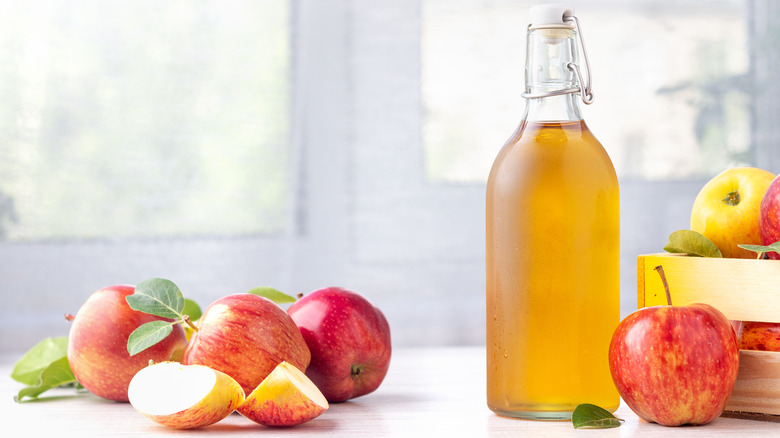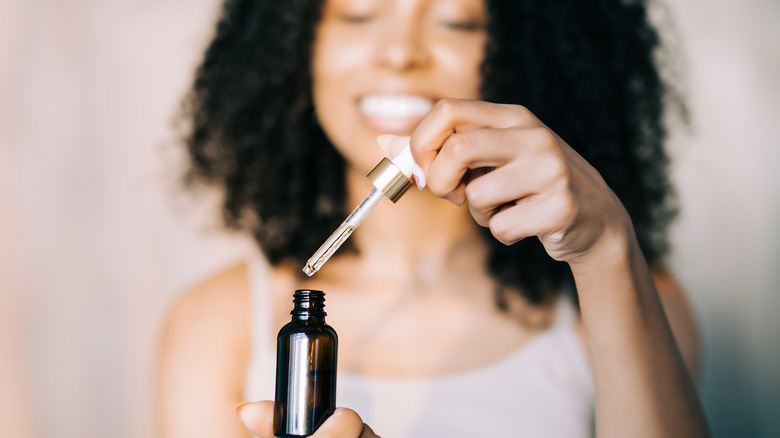Here's Why Apple Cider Vinegar Is Great For Your Skin
Cooks can ill afford to be fussy. And if they are as they size up their first recipe, they learn to grow out of it. Seeing meat, fish, and poultry in various stages of undress will do it to you. Still, most cooks have one pet peeve that sticks — maybe even literally — like the rolled-out dough they can never lift from the countertop or the mixture of ground beef and pork that stubbornly clings to their fingers. (Ah, but those meatballs are worth 15 hand washings.)
Ask any longtime cook for the one thing they love or hate the most about cooking, and they're apt to mention a certain smell. This seems logical because smell is the strongest of the five human senses (via Fifth Sense). People are thought to be able to distinguish an astounding one trillion smells (via the National Institutes of Health). But the one smell that many cooks never grow to like is one that registers on the olfactory scale as soon as a bottle of apple cider vinegar is opened. Made from fermented apple juice, apple cider vinegar is often found in marinades — in which the acid softens meat, fish, and poultry — as well as salad dressings, vinaigrettes, and chutneys.
While other ingredients in these concoctions disguise the strong smell of apple cider vinegar, no such calming occurs when you apply apple cider vinegar to your face. Nevertheless, it has many amazing benefits, so it's worth any potentially uncomfortable sensations.
Two acids merge to keep skin clear
Even a casual cook should be able to appreciate the process by which apple cider vinegar is made — a process that begins with what most people would say is a pleasant smell. First, chunks of apples are set in a bowl and covered with water, where they sit until the sugar makes ethanol. The inevitable onset of bacteria works to turn this alcohol into acetic acid (via The Conversation).
This is one of two powerhouse compounds that combine to make apple cider vinegar so effective at exfoliating, which unclogs pores and removes dead skin cells. The other compound is malic acid (via The Derm Review). Together, these two compounds reduce excess oil and bacteria, thereby creating a hostile environment for blemishes and breakouts, which they arguably deserve. The compounds are also thought to decrease the production of melanin, which leads to hyperpigmentation.
While these benefits may be downright intoxicating, the strong smell of apple cider vinegar portends an important warning: The Derm Review says that using too much apple cider vinegar or using it too often can "damage the skin's pH barrier."
Enjoy a good soak in ACV
In other words, less is more with apple cider vinegar, and this is easily accomplished by diluting it with water. In fact, Perfec-Tone notes that one part of apple cider vinegar to three parts water is a good place to start when mixing a topical facial treatment. If the idea of working with water appeals to you, then you might truly embrace another way to use apple cider vinegar on your skin: by taking a bath in it (via Healthline). Pour 2 cups of apple cider vinegar into a tub of warm water. As you soak in the apple cider vinegar bath, it can soothe dry skin while its antifungal properties get rid of body odor (as you contemplate the humorous irony).
Apple cider vinegar may also act as a remedy for people who contend with dandruff, though the research is still out on whether it's a perfect aid (via Medical News Today). As it's rubbed into the scalp, the vinegar's antibacterial and anti-fungal qualities go to work. To minimize the smell factor, you can put your hair over a tub and ask a helper to massage the vinegar through your hair and then rinse it free. And afterward? With perhaps a higher tolerance for the smell of apple cider vinegar, it seems appropriate to cook something special with it. One way or the other, apple cider vinegar is bound to make a fan out of you yet.


